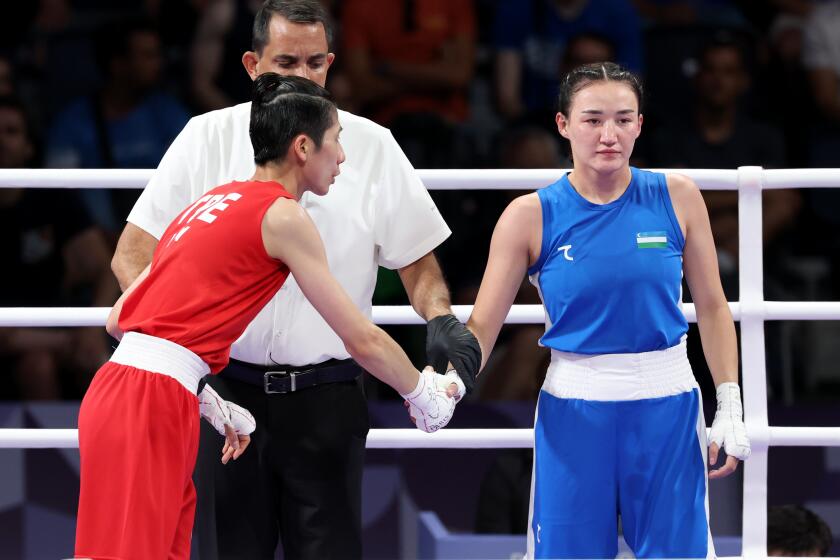âHe Can Take Itâ and Not Make It
In the summer of 1947, when Sugar Ray Robinson fought Clevelandâs Jimmy Doyle, he beat him so badly Doyle collapsed and died. Some days later, at the hearing into the death, the district attorney turned to Ray and asked accusingly, âCouldnât you see he was hurt?â Sugar Ray looked at him resentfully. âSir,â he told him, âitâs my business to hurt people.â
It was, unfortunately, too true. The business of boxing is hurting.
Gabriel Ruelas was tending to business on the night of May 6 in Las Vegas and the object of the business was a Colombian contender, Jimmy Garcia, to whom he was administering an uncharacteristic, unstylish whipping.
Jimmy was that most pathetic of pugilist types, the fighter who âcan take it.â He took it. By the 10th round, he was defenseless. But he wouldnât go down and out. How he answered the bell for the 11th round, no one could imagine. But 25 seconds into it even the referee had had enough. He called the fight off. Just in time for Garcia to collapse in his corner and go into a terminal coma. He died two weeks later.
It is the perverse nature of the business of boxing that it is not the knockout puncher who kills. It is the bludgeoning type fighter, the brawler whose blows never land cleanly, who produces the hemorrhages that produce the fatality. Rocky Marciano put three opponents in wheelchairs and walkers. Joe Louis just knocked them swiftly unconscious with the velocity of his punches. They were OK the next day. Max Schmeling is 90 years old, to give you an idea. And not in a walker.
Gabriel Ruelas is the super-featherweight (130-pound) champion of the world, a title he was defending in the Garcia fight. He remembers the fight not in its negative aspects but as one in which he was baffled by the ease of the contest. âI let up on him,â he says pitiably. âHe couldnât hurt me. It was like I had no opposition. So I backed off from him. I would hit him some combinations, then I would ease up. I thought, âIâm not going to knock this guy out, so, Iâll win an easy decision.â â
On reflection, itâs the worst thing he could have done. A 10-count would have been merciful. âHis expression didnât tell me anything,â Ruelas says. âI didnât think I was connecting with clean shots. I didnât know he was hurt that bad. I was a little surprised when the ref stopped it.â
Garcia should have swallowed his pride. But he was too busy swallowing blood. He didnât sink to the floor until he was told the fight was over. He never regained consciousness.
Death by boxing glove is all too common. It hovers over the sport like an incubus. Its mocking laughter rings out. The human brain was not designed to withstand repeated blows from a gloved fist. There are those who think a bare knuckle blow is more humane, but the reality is, there were fatalities in the bare-knuckle days. In sport, only autos kill more people than fists.
Confused and bewildered, Gabriel Ruelas hung around the hospital room of his fallen foe, sobbing in the arms of the mother, begging forgiveness. âI wished it were me,â he recalls. âI couldnât get his face out of my mind. I didnât think I could ever hit another human being in my life.â
But, history shows, fighters do fight again. Reality sets in. There are little mouths to be fed, bills to be met. Grief numbs itself.
So, Ruelas will go back in the ring at the Fantasy Springs Casino at Palm Springs on Friday. He meets Azumah Nelson, the durable Ghanan ex-champion in a 12-round defense of his title.
Will he be able to throw punches with the same ferocity as before? Or will the ghostly image of the dead foe haunt his efforts? Even Ruelas doesnât know. âOnly time will tell,â he shrugs.
If there is exculpation in the scenario, it lies in the fact that a ring fatality is often the effect not of the fight in which it occurs but in a previous fight. The handsome Argentine, Alejandro Lavorante, was ostensibly knocked out and killed by a journeyman pug, Johnny Riggins, in September 1962.
Not in the view of knowledgeable ringsiders. The bulk of the evidence has it that Lavorante was done in by two fistic encounters with Muhammad Ali and Archie Moore earlier that year. Both knocked him out. After the Moore fight, it took several minutes--and several doctors--to revive Alejandro. They advised him not to fight again.
In 1933, a heavyweight contender, Ernie Schaaf, was knocked out by Primo Carnera in 13 rounds and died. Most fight mobsters (in the case of Carnera, the term is well-chosen) ascribed the fatality to a fight Schaaf had before that one in which Max Baer had knocked him out at the bell and he left the ring on a stretcher. After all, Baer, who had a paving block for a right hand, was the closest thing to a serial killer boxing had. In 1930 he had killed Frankie Campbell (brother to the Dodgersâ famed first baseman, Dolph Camilli) in a fight in San Francisco.
Jimmy Garciaâs previous fight had been a war with a lethal puncher named Genaro Hernandez. Insiders think that was the fight that destroyed him.
So, even though itâs Gabriel Ruelasâ business to hurt people, his opponent might have entered the ring a dying man that night. In any case, he left it as one.
More to Read
Go beyond the scoreboard
Get the latest on L.A.'s teams in the daily Sports Report newsletter.
You may occasionally receive promotional content from the Los Angeles Times.










